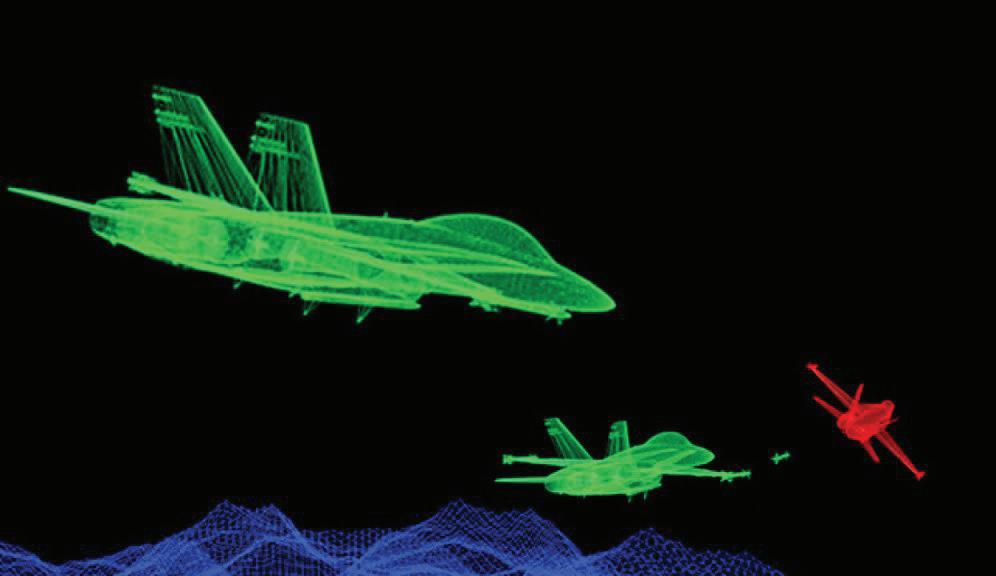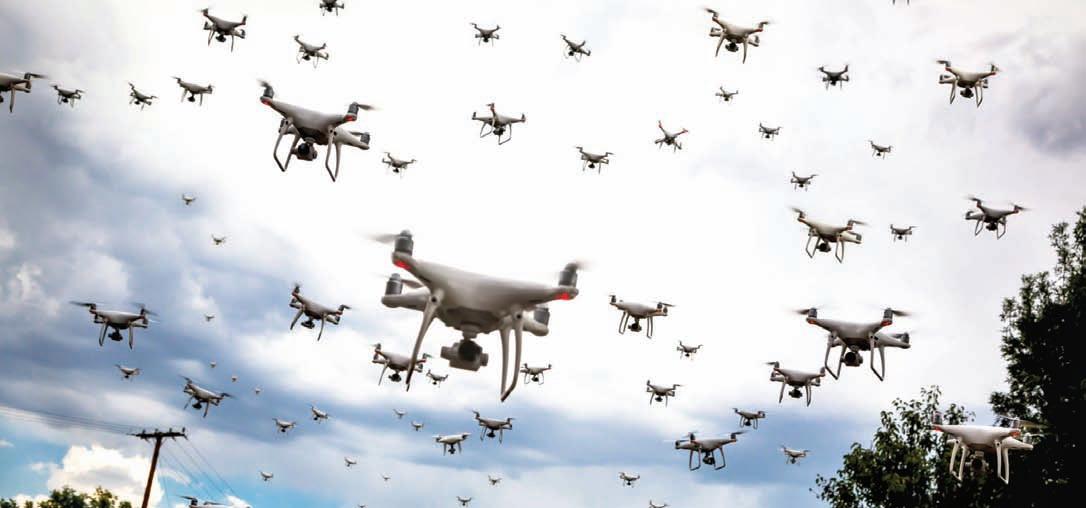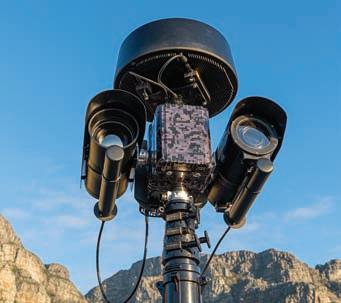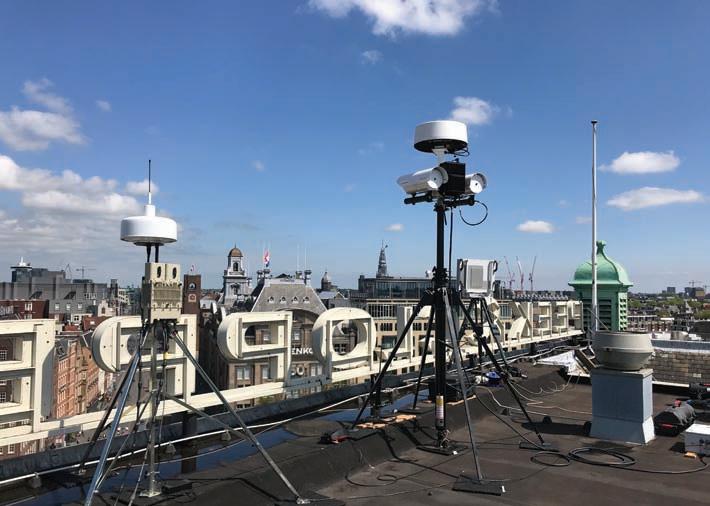
14 minute read
Disruptive Technologies in the Indian Military Matrix
This comes at a time when New Delhi’s strategic vulnerabilities have not only evolved but its technological gaps have also threateningly widened. Encountering both state and non-state actors, disruptive technological advancements have the potential to revolutionise India’s war-fighting capabilities. With the strengthening of a ChinaPakistan axis coupled with the prospect of an intentional leakage of disruptive technology by Pakistan to its non-state proxies, it is imperative for Indian defence planners to think out of the box.
New Delhi’s concerns for a potential trickle down of this technology to non-state
Advertisement
actors is well-founded against the backdrop of the Houthi rebels in Yemen claiming the responsibility for the successful attack on Saudi Arabian oil facilities through a coordinated swarm drone strike in September 2019. Other examples of nonstate actors exploiting freely available technology include the bombing of Ukrainian state ammunition dumps by alleged Ukrainian Separatists using thermite grenades delivered by drones causing great devastation between 2015 and 2017.
Closer to home, there have been several reports of Pakistan supported non-state actors using drones to deliver weapons to create internal instability through terror attacks in Punjab
With the strengthening of a China-Pakistan axis coupled with the prospect of an intentional leakage of disruptive technology by Pakistan to its non-state proxies, it is imperative for Indian defence planners to think out of the box in terms of the use of such technology
By HARSH V PANT AND ANANT SINGH MANN
I
n a timely intervention, Indian Army Chief General MM Naravane encouraged the nation’s armed forces “to pay adequate emphasis on the available disruptive technologies that have dual use and are being driven by commercial entities and innovations” and emphasised the need for their adapted incorporation into the “Indian context.” Accordingly, as an extension of this effort, the Defence Research and Development Organisation (DRDO), India’s premier defence technology supplier, is reported to have setup a panel charged with enhancing its efficiency by reappraising its 57 laboratories and reducing their technological overlapping.
and in the union territories of Jammu and Kashmir and Ladakh. With the advancement of additive layer manufacturing (3D-printing) and its potential to significantly reduce the costs to produce devices like drones, the accessibility of such technology to non-state actors will only continue to widen.
Although analysts have warned that these disruptive technologies ought not be considered the magic ingredient in military preparedness, it remains undeniable that their acquisition could potentially provide the state with a relative competitive advantage in the field. Over the last decade there have been several leaps in technologies and their projected trajectories which have provided militaries across the globe with a wide range of options and areas to enhance their capabilities.
At the vanguard of these advancements there are several key technologies which represent a significant disruption in contemporary military capabilities. Perhaps the most known and developing area with extensive capabilities of disruption is Artificial Intelligence (AI).
AI technology can be deployed in warfare using a combination of surveying, machine learning, searching and planning to ultimately analyse big data and automate decision-making. Through its unique and evolving algorithms, AI can provide a platform for the military which can streamline rapid responses to cyber-attacks, conventional onslaughts and other types of electronic barrages. AI’s wide range of applications has been in military use ever since its incorporation into the DART logistics and battle management system by the US during the First Gulf War in 1991.
Consequently, Russia and China, among other leading militaries have made an active effort to expand its usage. India has also followed suit by setting up a multi stakeholder task force in 2018 to formulate strategy to enhance the deployment of AI in its military functions, followed by the establishment of the Defence AI Council in 2019.
One of the most talked about extensions of AI has been its application in robotics to create smarter autonomous Unmanned (Aerial/Ground/Underwater) Vehicles. Their application in warfare is wide ranging from reducing casualties, to providing intelligence, surveillance and reconnaissance (ISR) collection in the harshest of weather conditions. Leaders in this field have gone one step further by creating ‘drone swarms’ under which a large group of drones can act in unison carrying out a variety of complex military manoeuvres. The US in this pursuit, has created its Low-Cost Unmanned Aerial Vehicle (UAV) Swarm Technology (LOCUST).
China has also greatly honed its drone capabilities with analysts speculating that each drone can be equipped with mortars, grenades, and machine guns in a networked and coordinated attack. India has a long way to go with its primary UAVs being the Israeli Searchers and Herons, while its few indigenously developed UAVs continue to lag behind in AI ALSO HAS THE POTENTIAL TO CONTORT AND MOULD INFORMATION ENABLING THE CREATION OF FORGERIES, ERODE PUBLIC TRUST, SPREAD FALSE NEWS AMONG OTHER THINGS. THIS NEW ‘DEEP FAKE AND DISINFORMATION’ CAPABILITY CAN INDEED BE USED DURING PEACE AND WAR TO WEAKEN THE ADVERSARY’S STATE MACHINERY AND CREATE DOMESTIC CHAOS


relative capabilities. However, in 2019 the US and India announced under their Defense Technology and Trade Initiative (DTTI) that they would jointly pursue development of swarm drones and anti-drone systems. Such technology can be of great utility to the Indian military, especially in patrolling inhospitable areas like the Aksai Chin.
AI also has the potential to contort and mould information enabling the creation of forgeries, of both photos and videos, enabling adversaries to control public discourse, erode public trust, spread false news, among other things. This new ‘deep fake and disinformation’ capability can indeed be used during peace and war to weaken the adversary’s state machinery and create domestic chaos. The US Defense Advanced Research Projects Agency (DARPA) in order to combat this has a Media Forensics project designed specifically to detect such warfare. While India too has been attacked by deep fakes at various points, it lacks a coherent policy or strategy to counter this disruptive technology.
Hypersonic weapons appear to be in vogue presently with their disruptive impact, in both their cruise (capable of altitudes up to 100,000 feet) and glide (capable of altitudes above 100,000 feet) variants with the contemporary ‘hypersonic arms race’ being led by the Chinese DF-17, Russian Sarmat and the US Hypersonic Conventional Strike Weapon.
The utility of these weapons is stored in their speed which is around five times the speed of sound (Mach 5) and consequently give them the ability to strike targets with high speed and precision virtually leaving little chance for their detection by the enemy. India also joined this race in 2019 with its indigenously developed Hypersonic

Technology Demonstrator Vehicle (HSTDV) which can travel up to a speed of Mach 6.
A step up from the hypersonic weapons has been the development of ‘directed energy weapons’ (DEW) which essentially use millimeter waves, microwaves and electromagnetic pulses to perform a range of functions from crowd control and destruction of electronic systems in given radiuses to precise and quick destruction of objects in space.
Following the US, China has deployed several types of DEWs ranging from antiSatellite lasers, to other highpowered microwave, railgun, radiofrequency and particle beam munitions. The DRDO has set up the Centre for High Energy Systems and Sciences and the Laser Science and Technology Centre for solely the development of DEWs, but production of a deployable weapon is awaited.
A step further into the future and at the cutting edge of technological disruption would perhaps be the harnessing of Quantum Technology and its application into the military sphere. China is at the helm of this innovation which promises numerous prospects once achieved.
Its military applications under the quantum key distribution, quantum cryptanalysis, and quantum sensing threaten to completely transform the military arena. It has been speculated that once achieved, this technology could provide the military with hack-resistant communications network, and unmatched computational superiority on the battle field.
In the light of these significant technological advancements, the DRDO still remains caught up in the development of more traditional forms of technology even as it continues to face a variety of issues like delays, under-budgeting and superannuated technology. While in the past the Indian programmes of missile, cyber and space have seen considerable development, a shift of gears is perhaps imperative to proactively respond to the challenges being posed by new and emerging disruptive technologies.
It is clear that indigenous production of such technologies remains a crucial factor in their realistic military incorporation. It is therefore vital for the government to create an environment conducive to such innovation, because a majority of these technologies grow out of commercial pursuits and then due to its dual-use nature can be transferred and applied to the evolving military needs.
Consequently, a civil-military synergy is critical for indigenous innovation and realistic technological enhancement. While recent steps by the Indian government to focus on incorporating these disruptive technologies is a welcome move, the only realisable and affordable route to achieve these innovations lie in government’s careful nurturing of a sustainable commercial domestic ecosystem.
In this direction, Prime Minister Narendra Modi’s recent address where he reiterated his emphasis on making the Indian defence sector selfreliant through policy reforms such as banning the import of 101 weapon systems and permitting 74 per cent Foreign Direct Investment through the automatic route for defence manufacturing sends out a positive signal that New Delhi remains committed to boosting domestic innovation and production. Given India’s strategic environment, the incorporation of such avantgarde innovations will not only help it to catch up with its adversaries but also ensure military preparedness against non-conventional threats.
The article was earlier published (https://www.orfonline.org/expertspeak/disruptive-technologies-in-theindian-military-matrix-72494/?amp) on Observer Research Foundation portal.
- The author is Director of Studies and Head of Strategic Studies Programme at ORF and the co-author is a Research Intern at this Public Policy Think Tank. WHILE IN THE PAST THE INDIAN PROGRAMMES OF MISSILE, CYBER AND SPACE HAVE SEEN CONSIDERABLE DEVELOPMENT, A SHIFT OF GEARS IS PERHAPS IMPERATIVE TO PROACTIVELY RESPOND TO THE CHALLENGES BEING POSED BY NEW AND EMERGING DISRUPTIVE TECHNOLOGIES

THREATENED BY DRONES? BUT WHO DEFENDS THESE THREATS?
XPELLER – WE BRING IT DOWN
Monitoring the airspace is an important task. Even more so when dangers are becoming smaller and smaller: The use and circulation of small drones has increased substantially over recent years and months. While some regulatory frameworks exist, their implementation has proven difficult in practice. Airports especially are highrisk areas, as a collision between drones and airplanes – whether intentional or not – may result in accidents and even deadly crashes. Added to that the risk of drones employed as weapons by dropping explosives, biological or chemical substances, it becomes clear that airports and other critical infrastructures must be continuously monitored, secured and have access to means of intervention in cases where drones may enter their airspace. Andleeb Shadman, Managing Director of Hensoldt Pvt. Ltd in an interesting conversation with Markus Wolf, Director Sales & Business Development of Xpeller Counter UAV Solution at Hensoldt Ventures.
Could you describe global threat perceptions for which global customers buy Counter UAV Systems and what are the key criteria that influence their choice in selecting the System?
Hostile UAVs are becoming one of the biggest threats is recent years. They are cheap, easy to operate, available everywhere, almost invisible and usable for a variety of attacks. Several

Shadman Andleeb, Managing Director, HENSOLDT India
incidents within the last few years have revealed that there is a rapidly emerging threat caused by small, cheap and commercially available drones. In 2016 alone there were 70 reported near misses at Heathrow. Recent incidents like the lethal drone attack on Saudi Arabia’s largest petroleum company and arms dropping by UAVs in Punjab, India from across the India-Pakistan border has alerted Indian security and intelligence agencies. It is estimated that India has over 6 lakh rogue or unregulated unmanned aerial vehicles (UAVs) and security agencies are looking for pragmatic solutions.

Markus Wolf, Head of Sales & Business Development at HENSOLDT Ventures, responsible for the Xpeller CUAV System
Whether they are used for trafficking, industrial espionage, sabotage, terrorist acts or even unintentional this phenomenon is an emerging threat that must be countered. To do so, it is key to detect and identify the drone and assess its threat potential at ranges from a few hundred meters up to several kilometres of distance from the sensitive area.
Practical Counter UAV solution (CUS) should maximize true positives and minimize false negatives. We have observed globally that key customer criteria for choosing a Counter UAV solution is influenced by local threat

How Mature is the solution? Are there success stories?
In 2018, HENSOLDT demonstrated its
perceptions, i.e. type and mission of UAV, legal, regulatory or practical constraints in installing radar and/or selection of counter measures and contentment of collateral damages etc.
Could you please describe Xpeller system?
The Xpeller approach towards countering the UAV threat is based on a multi sensor/ effector layer and a three step workflow: 1. Detect the potential threat with the best possible probability of detection. 2. Identify the potential threat as an actual threat with the least possible false alarm rate. 3. Act on the threat by raising alarms, or engaging the threat with a counter measure.
Xpeller is highly efficient, modular and scalable counter UAV system designed for civil and military domains. The system allows combination of radar, electro-optical and RF signals, all integrated in operational software for an optimized detection of unauthorized drone threats. The resulting signal domination allows an optimized usage of countermeasures such as intercepting signals to defeat the drone threat successfully.
What is the USP of HENSOLDT Solution?
The Counter UAV solution market has been consistently growing with increasing in threats due to terrorism and illicit activities across the world and rising incidences of security breaches by unidentified drones.
There are been numerous players in the market acting locally and globally offering variety of solutions.
The key differentiating factors for HENSOLDT solution are: 1. Mature and already in-service 2. Scalable and modular solution framework catering to different needs of customers 3. Man portable, Vehicle mounted and
Fixed installations 4. Catalogue of sensors and effectors to pick and chose 5. Very high probability of intercept and very low false alarm rate 6. Limited Interference with friendly use of air-space and spectrum. 7. Complete solution available based on inhouse-products with no third-party interdependency.



“Hensoldt’s Xpeller system securing Remembrance Day in Amsterdam”
Our proposed approach is to offer complete Xpeller solution framework to Indian customers. Through a Joint development we could realize an Indigenous Counter UAV solution in the most practical and incremental way, for example in supporting Indian capabilities like Sensors or 3rd Party Hard Kill effectors with selected Xpeller modules.
We offer following three variants of Xpeller for Armed forces and Critical National Infrastructure (CNI) like Airports, Govt Establishments, Power Stations, International Borders: • Xpeller Gear is a wearable and light weight configuration allowing highly mobile operations of patrol forces. • Xpeller Rapid is a mobile system configuration that is easily transferable
Xpeller counter-UAV system at the Airbus airfield in Hamburg. During the demonstration, Xpeller detected UAVs approaching from a number of locations and was able to identify a variety of UAVs, including small recreational models, from a distance of several miles away.
Among our most recent successes is supporting the German Armed Forces in the protection of their forward operating bases in their operational areas.
The Xpeller modules are used as part of container-based drone defence systems within the GUARDION overall system of ESG Elektroniksystem- und Logistik-GmbH and its partners for a total of five drone defence systems. “The Spexer2000 3D radar is characterized by outstanding detection capabilities, especially against asymmetric threats. The Z:NightOwl M camera was specially developed for high ranges. With it, we support drone defence against so-called Class I drones, that is, unmanned aircraft weighing up to 25 kg.
In addition to permanent deployment, customers also use the system for temporary protection of major events. A recent example was the deployment of Xpeller during the Dutch Day of Remembrance in Amsterdam in May

VADR catching drone in action
2020, marking the successful introduction of Xpeller as a service.
How do you see Indian market for counter drone solution? What are your plans to offer this solution to Indian customers?
India is the vast country with challenging security situations. There have been several instances related to drone threats in civil and military areas.
We are also cognizant about India’s uncompromising focus on Military selfReliance through “Make in India” policy.
and rapidly deployable. • Xpeller Guard is a fixed site system configuration that is installed for continuous operations in complex and wide surveillance
Xpeller with its inherent modularity of design, Multi-pronged Evolutionary approach involving technology and capability enhancement across the system in all components – sensors and effectors, feasibility of integration of parallel systems or add on Sensors and effectors in its architecture fits in well with this approach.










